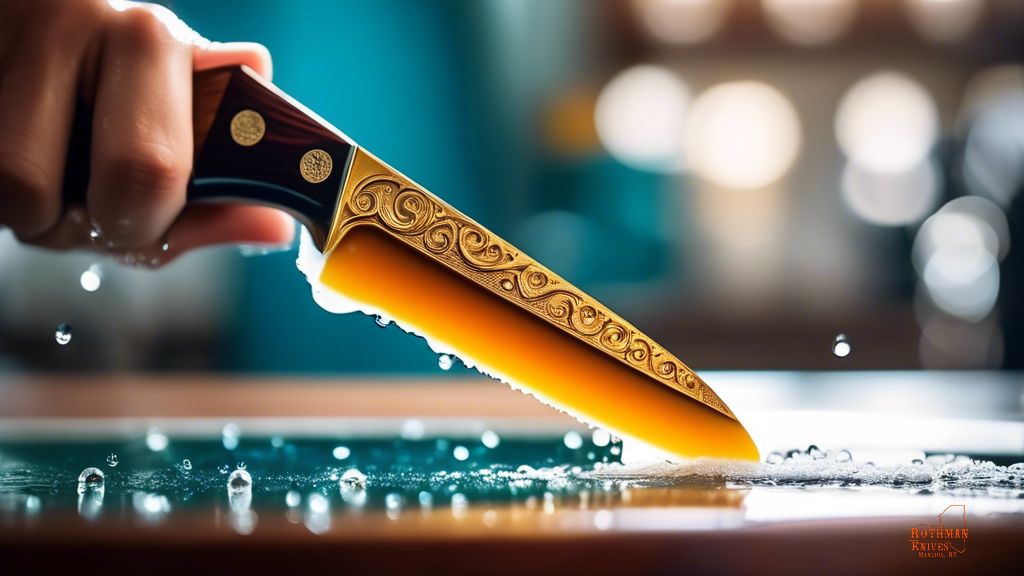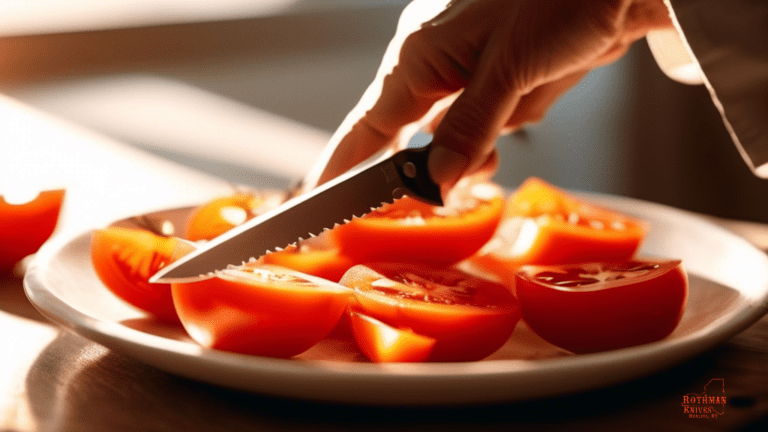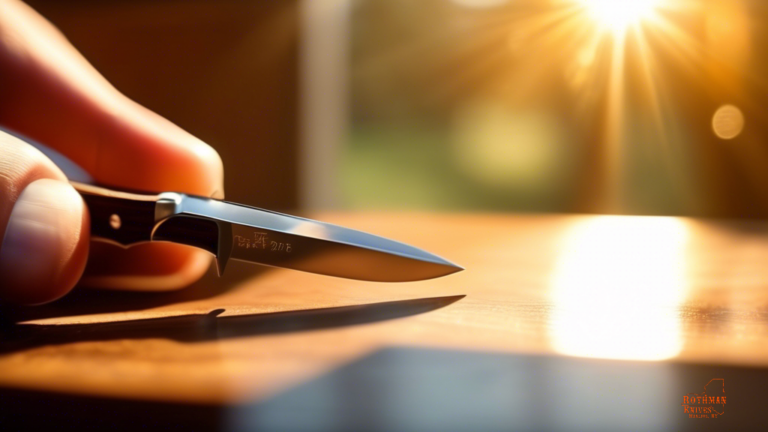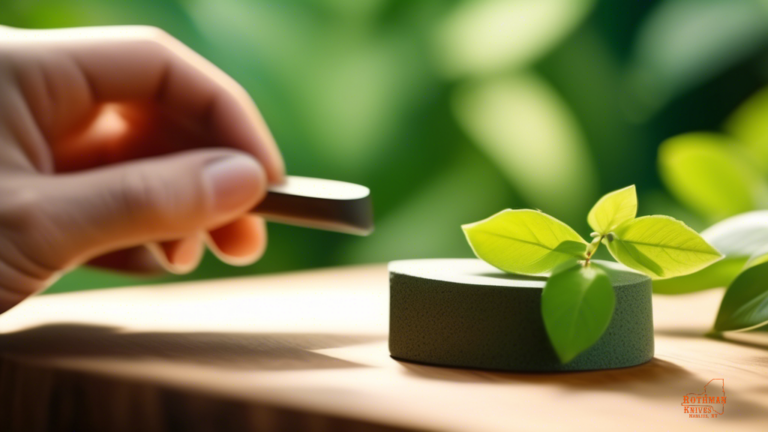Are you looking to keep your knife handles looking clean and pristine? If so, you’ve come to the right place! Cleaning knife handles may seem like a daunting task, but with the right techniques and supplies, you can easily maintain their appearance and functionality.
Whether you’re a professional chef or just someone who loves to cook at home, taking care of your knife handles is essential for both hygiene and aesthetics.
In this article, we will explore effective techniques for cleaning knife handles, from choosing the right cleaning supplies to proper storage and care tips. By following these steps, you will not only keep your knife handles in top condition but also feel a sense of pride in your kitchen tools.
So, let’s dive in and learn how to give your knife handles the attention they deserve!
Key Takeaways
- Regularly wipe down knife handles with warm, soapy water
- Disinfect and sanitize knife handles to keep them germ-free
- Polish and maintain knife handles to prevent corrosion and wear
- Store knives in a knife block or on a magnetic strip to maintain cleanliness and prevent damage
Choosing the Right Cleaning Supplies
When cleaning knife handles, it’s important to choose the right cleaning supplies for the job, ensuring that they are safe and effective for the material of the handle.
You want to make sure that the cleaning solution you use won’t damage or degrade the handle, so opt for gentle cleaners like mild dish soap or a vinegar solution.
Additionally, consider the type of material the handle is made of, as different materials may require specific cleaning products to maintain their quality.
As you browse through cleaning supplies, remember that your goal is to keep your knife handles looking as good as new.
Look for products that are specifically designed for the type of material your handles are made of, whether it’s wood, plastic, or metal.
By choosing the right cleaning supplies, you can ensure that your knife handles stay in top condition for years to come, giving you a sense of pride and belonging in your well-maintained kitchen tools.
Removing Dirt and Grime
To efficiently remove dirt and grime from knife handles, it’s important to regularly wipe them down with warm, soapy water. This simple step not only helps to keep your knife handles clean, but also prevents the buildup of bacteria and germs that can transfer onto your food.
By taking the time to clean your knife handles regularly, you’re not only ensuring the safety of your food preparation but also extending the lifespan of your knives.
In addition to using warm, soapy water, you can also use a soft-bristled brush to gently scrub away any stubborn dirt or grime. Be sure to pay extra attention to crevices and grooves where dirt can easily hide.
Once you have thoroughly cleaned the handles, be sure to dry them off completely to prevent any water damage. By following these simple steps, you can keep your knife handles looking clean and well-maintained for years to come.
Disinfecting and Sanitizing
Make sure you give those knife handles a good scrubbing to keep them germ-free and safe to use.
When it comes to disinfecting and sanitizing your knife handles, here are a few techniques to help you out:
- Use a mixture of warm water and dish soap to clean the handles thoroughly.
- Scrub the handles with a brush or sponge to remove any lingering germs.
- Rinse the handles with clean water to ensure all soap residue is removed.
- Finish off by wiping the handles with a disinfectant wipe for an extra layer of cleanliness.
By following these steps, you can ensure that your knife handles are not only clean but also sanitized, giving you peace of mind every time you use them.
Remember, a clean kitchen is a happy kitchen, and by taking care of your tools, you’re not just maintaining cleanliness but also creating a sense of belonging in your cooking space.
Polishing and Maintaining the Handle
Maintaining the handle’s shine is essential for the longevity of your knife. Just like how you take care of other valuable possessions, your knife handle deserves the same attention. Regular polishing not only keeps your handle looking sleek and stylish but also helps prevent corrosion and wear. By incorporating this simple step into your cleaning routine, you’re not only enhancing the appearance of your knife but also ensuring its durability for years to come.
Here’s a handy table to guide you through the polishing process:
| Step | Action | Time Needed | Frequency |
|---|---|---|---|
| 1 | Clean the handle | 5 minutes | Weekly |
| 2 | Apply metal polish | 10 minutes | Monthly |
| 3 | Buff the handle gently | 5 minutes | Bi-annually |
| 4 | Store in a dry place | – | After every use |
By following these simple steps and incorporating regular maintenance into your knife care routine, you’re not only ensuring the longevity of your knife handle but also becoming part of a community that values the art of knife maintenance. Join the ranks of knife enthusiasts who understand the importance of proper care and maintenance, and take pride in owning a well-preserved and polished knife handle.
Proper Storage and Care Tips
Ensure you store your knives in a dry and well-ventilated area to prevent rust and damage. Proper storage and care are essential to maintain the quality and longevity of your knife handles. Here are some tips to help you keep your knives in top condition:
- Use a knife block or magnetic strip: By storing your knives in a designated space, you not only keep them organized but also prevent them from knocking against other utensils, which can cause damage.
- Avoid storing knives in a drawer: Knives tossed into a drawer can easily get scratched or dented by other kitchen tools. Keep them safely stored in a block or on a magnetic strip.
- Regularly clean and dry your knives before storing: Make it a habit to clean and dry your knives after each use to prevent corrosion and maintain their sharpness. This simple step can go a long way in preserving your knife handles for years to come.
By following these storage and care tips, you can ensure that your knives remain in excellent condition, ready to assist you in all your culinary adventures. Remember, taking care of your tools not only enhances their performance but also shows respect for the craft of cooking.
Frequently Asked Questions
Can I use the same cleaning supplies for both wooden and plastic knife handles?
Yes, you can use the same cleaning supplies for both wooden and plastic knife handles. A gentle soap and warm water solution should do the trick. Just make sure to dry them thoroughly afterwards.
How often should I clean knife handles that are used daily?
You should clean knife handles used daily at least once a week to prevent the build-up of dirt and bacteria. Regular cleaning will also help maintain the handles’ appearance and prolong their lifespan.
Is it safe to use vinegar or bleach for disinfecting knife handles?
Using vinegar or bleach to disinfect knife handles is like using a sledgehammer to crack a nut. It may seem effective, but it can harm the handle’s material. Stick to gentle cleaning methods for safety.
Are there any specific techniques for cleaning knife handles with intricate designs or patterns?
When cleaning knife handles with intricate designs or patterns, use a soft-bristled brush or toothbrush to gently scrub hard-to-reach areas. Avoid harsh chemicals and opt for mild soap and water to preserve the integrity of the handle.
Can I use metal polish on knife handles made of materials other than metal?
Sure, go ahead and use metal polish on non-metal knife handles. It’ll work like a charm…just kidding! Stick to gentle cleaners suitable for the material to avoid damaging your knife handle.
Last Updated: July 15, 2024
Verified and Approved by:

Mike Rothman
Founder of Rothman Knives
Like This Article?
Share with your friends
Table of Contents
Latest Articles
Keep Reading
-
Unveiling The Scary Sharp Method: Razor-Sharp Results
Unveil the secrets of the Scary Sharp Method and achieve razor-sharp results effortlessly! Learn how to sharpen like a pro now for precision cuts every time. Click here to master this game-changing technique!
-
Essential Safety Tips For Using Whittling Pocket Knives
Learn how to stay safe while using pocket knives for whittling with these essential safety tips. Don’t risk injury – read our guidelines now and start carving safely today!
-
Choosing The Right Knife Sharpening Stones
Learn how to choose the best knife sharpening stones for your kitchen knives and sharpen like a pro! Find out expert tips and tricks to keep your blades sharp and ready for any task. Click here to master the art of knife sharpening today!




